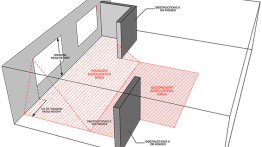Daylighting and Codes

A sidelighted room with sufficient daylight as per Std. 90.1, a leading national model energy code
This online lecture series reveals how daylighting related provisions of model energy codes are being refined to capture the total impact of daylight on whole building energy reduction. Building and energy codes are at the forefront of our nation’s strive toward a "net zero" environment by 2030. To achieve this rapid transformation, daylighting and the control of electrical lighting have been cast a critical role. The online lectures explain how daylighting related provisions are targeting increasingly stringent energy efficiency goals and are moving out from the realm of high performance and reach codes into our nation’s baseline model energy codes.
Presentation Objectives
1) Introduce the drivers shaping the current set of building energy codes, the bodies responsible for their development, and the processes in place for their revision, adoption and enforcement.
2) Provide a comprehensive overview of daylighting provisions within the current revisions of the model building energy codes, namely 2010/2013 ANSI/ASHRAE/ IESNA Standard 90.1, Energy Standard for Buildings Except Low-Rise Residential Buildings (Std. 90.1) and 2012 International Energy Conservation Code (IECC).
3) Explain the intricate set of daylighting regulations that exist on state and city level (New York State and New York City) and in recent planning initiatives.
Format
This is an online course with 3 sessions. The first and third sessions are synchronous with a live instructor. Participants must log in on November 4 and November 18 at 1:00 p.m. EST. The second session is asynchronous and may be taken at any time between the first and last session.
Course Fee & Registration Info
Course Tuition: $250
For information and registration, 212-353-4198 or davidg@cooper.edu
Note: This course has a recommended pre-requisite. Participants should have taken the IES Daylighting Seminar 6-11, or the Daylighting Fundamentals course from Cooper Union, or have equivalent experience.
The seminar series qualifies for 3.5 IES CEUs, AIA LUs, and GBCI CEs.
Speaker
Matthew Tanteri, FIES, Educator IALD, CPHC, SBSE is Principal of the award-winning lighting design firm Tanteri + Associates. He is a Fellow of the IES, a Past President of the New York IES Section, and a member of the following IES committees: Daylighting Committee, Sunlighting Subcommittee, Daylighting Metrics Committee, Museum and Art Gallery Lighting Committee and the Technical Review Committee. He is former Assistant Professor at the School of Constructed Environments at Parsons The New School of Design, a frequent lecturer at lighting related events such as Lightfair, and has authored and contributed to the writing and graphic design of several IES daylighting related publications such as IES SEM-6-11 Daylighting and RP-5 Recommended Practice for Daylighting Buildings. As a Certified Passive House Consultant (CPFC) he couples his knowledge of daylighting with low energy building design.




